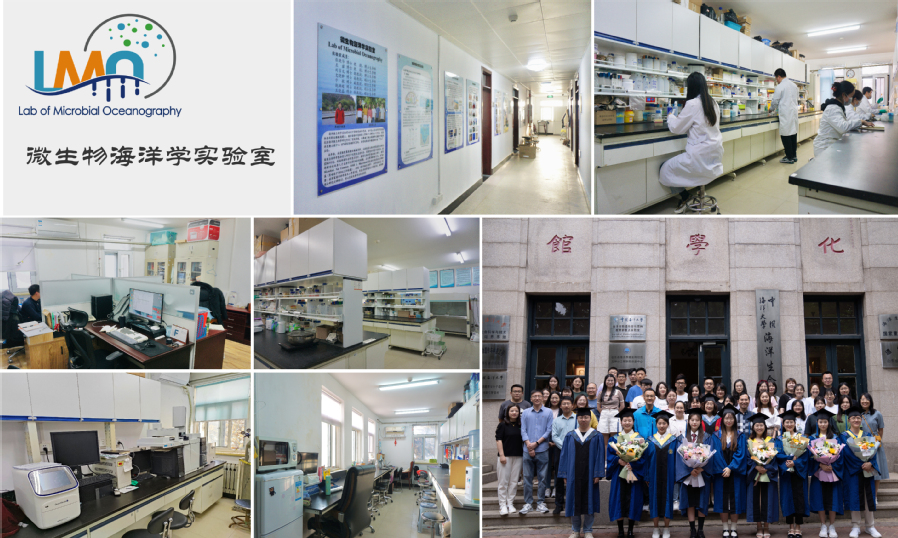
微生物海洋学实验室目前有7名教师,其中1名教授,6名副教授,另有2名博士后。实验室主要研究方向:1)海洋微生物的生物地球化学作用(包括微生物在海洋环境中的时空分布格局及环境响应,海洋微生物在碳循环、氮循环、硫循环中的作用等);2)海洋细菌的群体感应及群体感应淬灭(包括细菌密度感应对颗粒有机碳降解的调控作用);3)海洋微生物的分离鉴定及资源开发(包括海洋微生物分离培养新技术的建立、新物种的分类鉴定、菌种库建设以及酶资源开发等)。
近三年研究成果包括:1)首次发现海洋细菌能够合成“冷室气体”DMS的前体物质DMSP,解析了细菌合成DMSP的通路,并揭示了超深渊细菌可利用二甲基丙酸内盐(DMSP)抵抗高静水压力,指出异养细菌是深渊海水和沉积物中DMSP的重要生产者;2)发现烃类降解菌在马里亚纳海沟底层水出现勃发,并在深渊底部沉积物中鉴定出了大量生物来源烷烃,指出烷烃可能是万米水体微生物的重要“燃料”;3)发现深渊海沟水体中的氨氧化古菌可活跃参与氨氧化和碳固定,并演化出特殊的生存机制(如特殊的渗透保护剂及能量代谢途径等)以适应深渊极端环;4)揭示了近海底栖生境微生物的群落构建机制,提出了群落构建过程影响物种互作模式的新观点。以上科学发现获得了领域内专家的一致认可,相关研究成果分别发表于顶级杂志Nature Microbiol、Nature Commun、ISME J、Microbiome等上。
国家自然科学基金重点项目1项
国家自然科学基金委重大研究计划重点支持项目1项
国家重点研发计划政府间国际科技创新合作重点专项1项
国家自然科学基金面上项目3项及青年项目2项
*通讯作者,#共同第一作者
1. Zheng Y, Wang J, Zhou S, Liu J, Xue C-X, Williams BT, Zhao X, Zhao L, Zhu X-Y, Sun C, Xiao T, Todd JD*, ZhangX-H*. 2020. Bacteria are important dimethylsulfoniopropionate producers in marine aphotic and high-pressure environments. Nature Communications, doi: 10.1038/s41467-020-18434-4
2. Curson A, Liu J, Martinez AB, Green R, Chan Y, Carrion O, Williams BT, Zhang S-H, Yang G-P, Page PCB, Zhang X-H* & Todd JD*. 2017. Dimethylsulphoniopropionate biosynthesis in marine bacteria and identification of the key gene in this process. Nature Microbiolology, 2: e17009.
3. Liu J, Zhu S, Liu X, Yao P, Ge T, Zhang X-H*. 2020. Spatiotemporal dynamics of the archaeal community in coastal sediments: assembly process and co-occurrence relationship. ISME J, 14:1463–1478.
4. Zhong H, Lehtovirta-Morley L, Liu J, Zheng Y, Lin H, Song D, Todd JD, Tian J, Zhang X-H*. 2020. Novel insights into the Thaumarchaeota in the deepest oceans: their metabolism and potential adaptation mechanisms. Microbiome, 8:78.
5.Wang X, Liu J, Liang J, Sun H, Zhang X-H*. 2020. Spatiotemporal dynamics of the total and active Vibrio spp. populations throughout the Changjiang estuary in China. Environ Microbiol, 2020, 22,10:4438-4455
6.Zhang, Y., Yao, P., Sun, C., Li, S., Shi, X., Zhang, X. H., & Liu, J*. 2021. Vertical diversity and association pattern of total, abundant and rare microbial communities in deep-sea sediments. Molecular Ecology, 30,12: 2800-2816.
7. Liang J., Liu J., Zhan Y., Zhou S., Xue C-X., Sun C., Lin Y., Luo C., Wang X., Zhang X-H*, 2021. Succession of marine bacteria in response to Ulva prolifera-derived dissolved organic matter. Environ Int, 155: 106687.
8.Xue C-X, Zhang H, Lin H-Y, Sun Y, Luo D, Huang Y, Zhang X-H*, Luo H*. 2020. Ancestral niche separation and evolutionary rate differentiation between sister marine flavobacteria lineages. Environ Microbiol, 2020, 22: 3234–3247.
9. Liu J, Zheng Y, Lin H, Wang X, Li M, Liu Y, Yu M, Zhao M, Pedentchouk N, Lea-Smith DJ, Todd JD, Magill CR, Zhang W-J, Zhou S, Song D, Zhong H, Xin Y, Yu M, Tian J*, Zhang X-H*. 2019. Proliferation of hydrocarbon degrading microbes at the bottom of the Mariana Trench. Microbiome, 7: 47.
10. Liang J, Liu J, Wang X, Lin H, Liu J, Zhou S, Sun H, and Zhang X-H*. 2019. Spatiotemporal dynamics of free-living and particle-associated Vibrio communities in the northern Chinese marginal seas. Appl Environ Microbiol, 85:e00217-19.